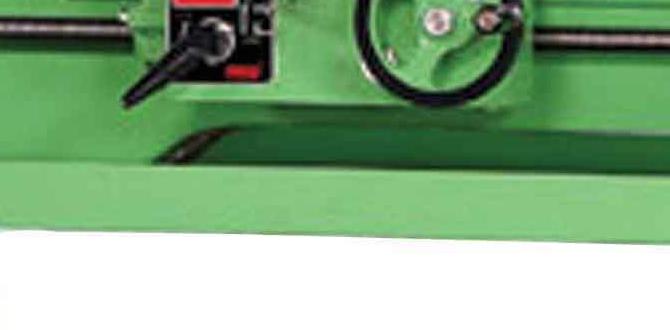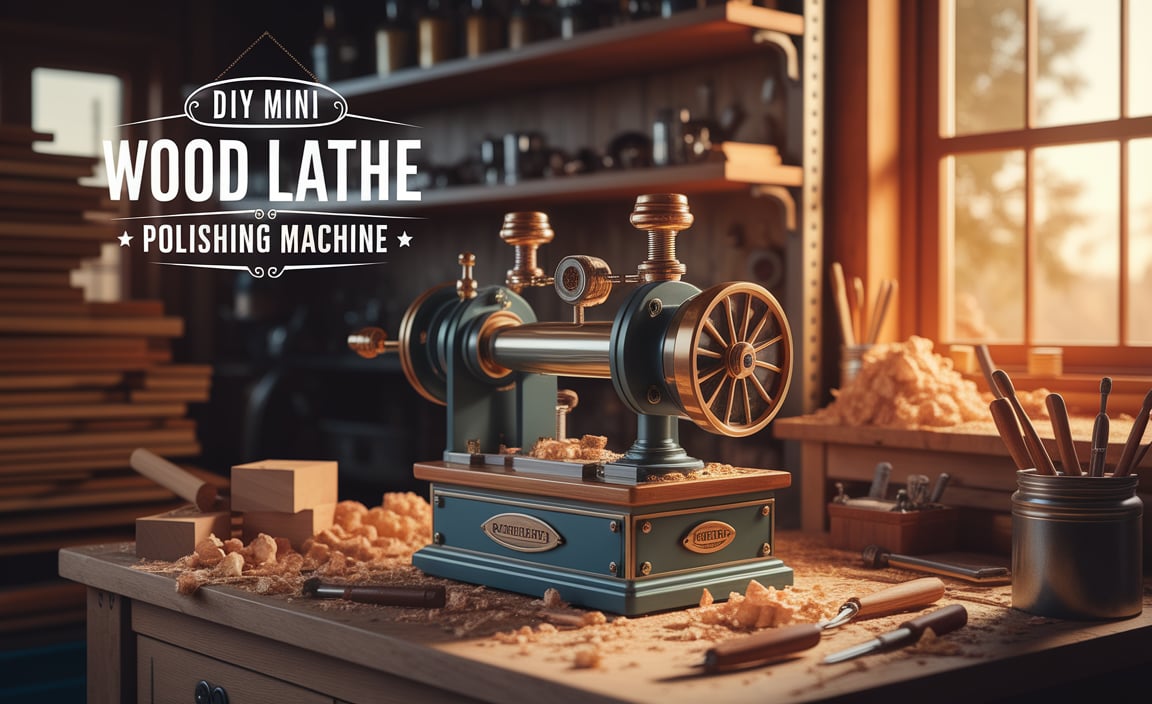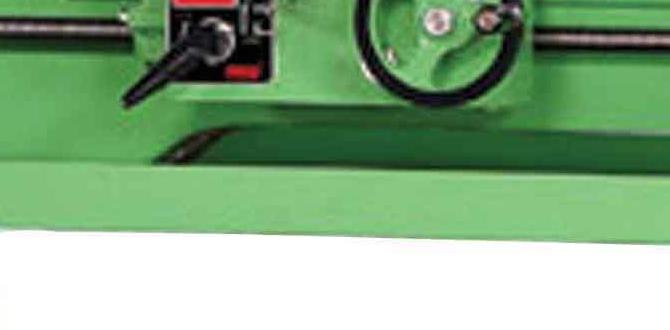Quick Summary
A chuck for a lathe is your essential workholding tool, securely gripping your workpiece so you can turn and shape it accurately and safely. Understanding the different types, how they work, and how to choose the right one is crucial for any turner, from beginner hobbyists to seasoned professionals. This guide breaks it all down simply.
Welcome to Lathe Hub! If you’re getting started with a lathe, you’ve probably noticed all sorts of accessories and attachments. One piece of equipment that stands out as absolutely vital is the chuck. It’s the part that holds your project material onto the spinning lathe. Without a good chuck, you can’t safely shape your wood or metal. It might seem a bit confusing at first with all the different kinds and sizes, but don’t worry! We’re going to walk through exactly what a lathe chuck is, why it’s so important, and what you need to know to pick the very best one for your needs.
Imagine trying to carve a sculpture while the clay keeps slipping around – frustrating, right? That’s what working on a lathe without a proper chuck feels like. This guide will demystify lathe chucks, making it easy for you to understand and confidently choose the right tool to get your projects spinning smoothly and securely.
What Exactly is a Lathe Chuck?
At its core, a lathe chuck is a clamping device that attaches to the spindle of your lathe. The spindle is the part of the lathe that rotates. The chuck’s job is to firmly grip the material you want to work on – this material is called the workpiece. Think of it as the hand that holds your project steady while the rest of the lathe does the shaping.
The gripping mechanism varies depending on the type of chuck, but they all serve the same purpose: to hold the workpiece securely enough to withstand the forces generated during machining. This security is paramount for both safety and accuracy. A loose workpiece is not only dangerous but will also result in poorly made parts.
Why is a Chuck So Essential for Your Lathe?
You might be tempted to think of other tools as more “exciting,” but the chuck is the bedrock of almost any lathe operation. Here’s why it’s truly indispensable:
- Safety First: This is the number one reason. A workpiece spinning at high speeds needs absolute security. If it comes loose, it can fly off the lathe with tremendous force, causing serious injury to the operator or damage to the workshop. A well-fitted and properly tightened chuck prevents this.
- Accuracy and Precision: For any turning operation to be successful, the workpiece must be held perfectly centered and without wobble. A good chuck ensures your material is held true, allowing for precise cuts and symmetrical shapes.
- Versatility: Different chucks are designed to hold various shapes and sizes of workpieces, from small rods to large blanks. Having the right chuck opens up a world of project possibilities.
- Efficiency: Quickly and securely mounting different workpieces saves you a lot of time compared to less robust methods of holding.
Types of Lathe Chucks: A Beginner’s Guide
This is where things can get a little detailed, but don’t let it overwhelm you. There are several common types of lathe chucks, each suited for different tasks and materials. We’ll break down the most important ones.
1. Three-Jaw Scroll Chucks (Universal Chucks)
This is by far the most common type of chuck you’ll encounter, especially for general-purpose metalworking and woodworking lathes. They are often called “universal chucks” because all three jaws move simultaneously when you operate the chuck key. This synchronized movement means they grip round and hexagonal stock perfectly centered, every time.
- How they work: A scroll plate, which is a grooved disc, rotates when you turn the chuck key in one of the sockets. This scroll plate meshes with a rack on each jaw, causing them all to move in or out together.
- Pros:
- Rapid, easy operation.
- Self-centering (ideal for round and hexagonal stock).
- Good for general-purpose use.
- Relatively affordable.
- Cons:
- Not as precise as some other types for holding irregularly shaped or non-round stock.
- Jaw alignment can sometimes be affected by wear, slightly reducing accuracy over time.
- Best for: Round bars, shafts, tubing, and general turning on metal and wood lathes.
2. Four-Jaw Independent Chucks
As the name suggests, these chucks have four jaws, and each jaw can be moved independently using its own screw. This independence is their key advantage.
- How they work: Each jaw has its own screw that you turn with a chuck key to move it in or out. This allows you to precisely align and center irregularly shaped objects.
- Pros:
- Excellent for holding square, rectangular, or irregularly shaped workpieces.
- Can achieve very high accuracy for centering off-center items.
- Strong gripping power.
- Cons:
- Slower to operate than three-jaw chucks.
- Requires more skill to ensure precise centering, especially for round stock.
- Not self-centering, so you need to measure and adjust each jaw carefully.
- Best for: Square stock, flats, irregularly shaped castings, or when you absolutely must have an odd-shaped part perfectly centered.
3. Collet Chucks
Collet chucks are a bit different. They use a series of hardened steel bushings called “collets” to grip the workpiece. The collet is typically a split sleeve that slides into the chuck body. When you tighten the chuck, the collet closes down onto the workpiece.
- How they work: A collet has a tapered exterior and a split interior. It’s inserted into a matching tapered hole in the chuck body. As the collet is drawn into the chuck body, the splits close, gripping the workpiece with immense, uniform pressure.
- Pros:
- Excellent for holding smaller diameter, precise work.
- Very high accuracy and concentricity.
- Provides a very strong and uniform grip over the length of the collet.
- Quick to load and unload.
- Cons:
- Each collet is made for a specific size range; you need a set of collets for different diameters.
- Generally more expensive than scroll chucks.
- Not ideal for very large or irregularly shaped workpieces.
- Best for: Holding rods, small diameter parts, precision shafts, and when minimizing runout is critical. Common in CNC machining and for certain high-precision manual operations.
4. Drill Chucks
While not a primary chuck for general turning, a drill chuck is essential for holding drill bits, reamers, and other small cutting tools when you need to bore holes precisely in the center of a workpiece mounted in another chuck (like a three-jaw or four-jaw). Some small hobby lathes come with a drill chuck as their primary workholding device.
- How they work: Similar to a small three-jaw scroll chuck, but designed for smaller tools. They use three jaws and a geared mechanism to grip the shank of twist drills.
- Pros:
- Securely holds drill bits and other small shank tools.
- Easy to operate.
- Relatively inexpensive.
- Cons:
- Not designed to hold larger workpieces for turning.
- Limited gripping capacity compared to main lathe chucks.
- Best for: Holding twist drills, reamers, and taps for precise hole-making operations without removing the workpiece from the lathe.
Chuck Mounting and Spindle Threads
This is a critical aspect for fitting your chuck to your lathe and is very important for safety and correct operation. Lathes have different spindle noses, and chucks are designed to mount onto these specific noses.
The most common types of spindle noses and their corresponding chuck mounting systems are:
- Threaded Spindles: This is the simplest and most common on smaller or older lathes. The spindle has a male threaded section, and the chuck has a matching female thread. You simply screw the chuck onto the spindle. Common thread sizes include 1″x8 TPI (Threads Per Inch), 3/4″x10 TPI, etc. You need to know the exact thread size of your lathe’s spindle.
- Camlock Spindles (D1-x): Common on South Bend lathes and many other moderate-sized machines. These feature hardened steel “cam” pins that lock into corresponding holes in the chuck flange. This is a quick-change system. The “D1” stands for “D-type spindle nose,” and the “x” (e.g., D1-4, D1-6) refers to the size and number of camlocks.
- Adjustable Locknut Spindles (L00, L0, L1, etc.): Similar to camlock but uses a threaded collar with locking pins to secure the chuck. This is a very robust system.
- A2 Spindles: A modern standard for many manual and CNC lathes, similar in concept to camlock but with keyways for registration and a threaded ring to pull the chuck onto the spindle. Sizes like A2-4, A2-5, A2-6 are common.
Why it matters: Using the wrong chuck mount can damage both the lathe and the chuck, and more importantly, it may not hold the workpiece securely. Always verify your lathe’s spindle type and thread size. Many manufacturers provide this information in their manual. If you’re unsure, measure the threaded section of your spindle or consult with a more experienced machinist or the lathe manufacturer.
Choosing the Right Chuck for Your Lathe and Needs
With so many options, how do you make the right choice? Here’s a step-by-step approach:
Step 1: Identify Your Lathe’s Spindle Type
As discussed above, this is the absolute first step. You must buy a chuck that is compatible with your lathe’s spindle nose. Check your lathe’s manual or measure the spindle yourself. Trying to force an incompatible chuck can lead to disaster.
Step 2: Consider Your Primary Materials and Shapes
- Woodworking: If you’re mostly turning wood, a 3-jaw scroll chuck is usually a great starting point. For larger wood projects, you might consider a faceplate or specialized woodturning chucks.
- General Metalworking: A 3-jaw scroll chuck is excellent for round stock. If you frequently work with square or irregularly shaped metal, a 4-jaw independent chuck is a valuable addition.
- Precision Work/Small Parts: For high-precision work, especially with smaller diameter metal stock, a collet chuck system is often the best choice for accuracy and repeatable results.
Step 3: Think About Your Projects
What do you actually plan to make? If you’re just making simple round parts, a 3-jaw is fine. If you dream of making complex, off-center items, you’ll need a 4-jaw. If you’re making small, intricate components, consider collets.
Step 4: Set Your Budget
Lathe chucks can range from a couple of hundred dollars for a basic 3-jaw on a small lathe to several thousand dollars for high-end, specialized chucks. Basic, reliable chucks are available for most hobbyist budgets.
Step 5: Size Matters
Chucks are sized by their diameter. Common sizes for hobby lathes are 3 inches, 4 inches, 5 inches, and 6 inches. The chuck should be appropriately sized for your lathe. A giant chuck on a tiny lathe is unwieldy and can be dangerous, while a tiny chuck on a large lathe won’t offer enough support for larger workpieces.
Recommended Chucks for Different Lathe Types
Here’s a general recommendation based on common lathe usage:
Small Hobby Lathes (Wood or Metal):
- A 3-inch or 4-inch 3-jaw scroll chuck with the correct spindle thread mount is usually the most versatile and recommended first chuck.
- For woodworking, a faceplate might also be included or considered for larger, flat projects.
Medium Hobby/Entry-Level Professional Lathes:
- A 5-inch or 6-inch 3-jaw scroll chuck is an excellent all-around choice.
- If your work frequently involves square or odd shapes, investing in a 5-inch or 6-inch 4-jaw independent chuck is highly recommended.
- Consider if a set of collets for your specific spindle mount is available and within budget for high-precision work.
Larger Metalworking Lathes:
- You’ll typically see 6-inch, 8-inch, or larger 3-jaw and 4-jaw chucks.
- Collet chucks or specialized power chucks (which are automated and used on CNC machines, but the principle of collets is similar) become more common.
Using Your Lathe Chuck Safely and Effectively
Once you have your chuck, using it correctly is vital. Here are some key safety and usage tips:
- Read the Manual: Always read the manufacturer’s instructions for your specific chuck.
- Cleanliness is Key: Keep your chuck, spindle, and workpiece clean. Dirt and debris can cause the chuck to grip unevenly or slip.
- Proper Mounting: Ensure the chuck is correctly and securely mounted to the spindle. For threaded chucks, tighten them firmly. For camlock or A2 spindles, ensure all locking mechanisms are engaged properly. Never force a chuck onto a spindle.
- Inspect Jaws: Before gripping a workpiece, check that the hardened jaw inserts are free from damage and securely fitted.
- Grip Force: For 3-jaw chucks, tighten as firmly as you can with the chuck key. The scroll mechanism is designed to provide significant clamping force. For 4-jaw chucks, try to apply equal pressure to each jaw.
- Test the Grip: After mounting the workpiece, give it a gentle tug by hand to ensure it’s not going to shift.
- Set Speeds Appropriately: The speed at which you can safely rotate a workpiece depends on its size, material, and how it’s held. Larger or less securely held workpieces require slower speeds. Consult your lathe’s manual and general machining guides for safe speed recommendations. For instance, a workpiece held in a 4-jaw chuck might need to be run slower than the same workpiece in a 3-jaw chuck. The Occupational Safety and Health Administration (OSHA) has extensive guidance on machine tool safety, which includes general principles applicable to lathe operations.
- Never Leave the Chuck Key Inserted: This is a cardinal rule! Always remove the chuck key immediately after use. Forgetting will almost certainly lead to the key being thrown at high speed by the spinning chuck, posing a severe hazard.
- Periodic Maintenance: Lubricate your chuck periodically according to the manufacturer’s recommendations to ensure smooth operation and longevity.
Chuck Accessories and Upgrades
As you become more experienced, you might consider some accessories or upgrades:
- Soft Jaws: These are blank jaws that can be machined to perfectly match the shape of an irregularly shaped workpiece. They are then fitted to your chuck just like the standard jaws.
- Jaw Inserts: Many chucks allow you to swap out different types of jaw inserts for specialized gripping needs.
- Chuck Wrench Sets: Having a few different sizes or types of chuck keys can be handy.
- A Second Chuck: Many machinists eventually have multiple chucks – perhaps a general-purpose 3-jaw and a specialized 4-jaw or collet set.
Chuck Maintenance and Longevity
To get the most out of your lathe chuck and ensure it performs reliably for years, follow these maintenance tips:
- Regular Cleaning: After each use, wipe down the chuck body and jaws. Remove any chips, dust, or coolant.
- Lubrication: Consult your chuck’s manual for recommended lubricants and intervals. Typically, the scroll, jaw slides, and threaded components need occasional lubrication.
- Check Jaw Fit: Periodically check that the jaws are seated correctly and that all screws are tight.
- Storage: If you have multiple chucks, store them carefully to prevent damage to the jaws or threads. A wooden box or dedicated rack is




